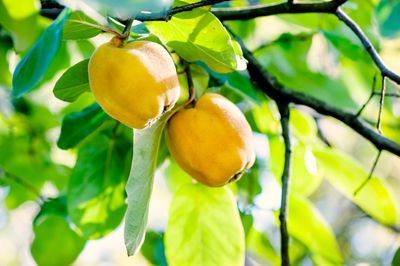What is Quince?
The quince is a fruit that has been forgotten by many, but it is also one that deserves a comeback. A quince is a fruit tree that grows to about 8 to 15 feet (2-5 m.) in height at maturity. It grows twisted and gnarled branches that add great visual interest to the garden at all times of the year. In spring, it blooms and in late summer it produces the quince fruit: a hard, acidic, apple-like fruit that is wonderful when cooked or baked.
Quince Fruit Varieties
There are several different quince tree types, varieties, and cultivars that you can choose from to add this interesting tree and tasty fruit to your garden and kitchen. When very ripe, these fruits can be eaten raw, but most are too hard and should be cooked first. They can also be used to make jellies because quince is packed with pectin. Here are some kinds of quince to try in your garden: Orange. Most varieties of quince are cultivars of the species Cydonia oblonga. One of these is ‘Orange,’ and it produces a round, very fragrant fruit with an orange-tinted flesh. This is one of the softer quince fruits, so if you want to try eating quince raw, this is the way to go. Cooke’s Jumbo. This cultivar produces pretty, white-pink flowers in the spring and fruit that is large and pear-shaped. ‘Cooke’s Jumbo’ is best used for baking, poaching, and making preserves and jellies. Champion. The ‘Champion’ cultivar is well known among quince enthusiasts for its delicate and lemon-like flavor. The fruit is pear-shaped and has a fuzzy, golden skin. It produces fruit later in the fall. Pineapple. A popular cultivar, ‘Pineapple’ is named for its flavor. The aroma and taste are very similar to pineapple. This tasty quince is used for baking and cooking and is one of the most commonly grown cultivars. Rich’s Dwarf. For a smaller tree that produces a large fruit, go for ‘Rich’s Dwarf.’ This cultivar produces a large fruit, but on a dwarf tree that will only grow to 8 or 10 feet (2-3 m.). Flowering Quince. Another species of tree that is called quince is flowering quince, Chaenomeles speciosa. The most characteristic aspect of this tree is its bright, flame-colored flowers. The fruit is not as notable as those of C. oblonga, which is why most gardeners choose it for the ornamental blooms.
